Analysing Mr. Simon's Case with Motivation Theories - HRM11117 Essay
VerifiedAdded on 2023/04/05
|6
|1359
|366
Essay
AI Summary
This essay explores the application of motivation theories to address the issue of employee disillusionment within a retail organization, focusing on the case of Mr. Simon, a long-serving line manager who has been repeatedly unsuccessful in securing a promotion. It discusses McGregor's X and Y theory, Maslow's hierarchy of needs, and Herzberg's two-factor theory, examining their advantages and disadvantages in the workplace. The essay further analyses the implications of these theories on employees and the workplace, specifically in relation to Mr. Simon's situation, and concludes with the importance of employee recognition and promotion for motivation and organizational success. This assignment solution is available on Desklib, a platform providing study tools and resources for students.
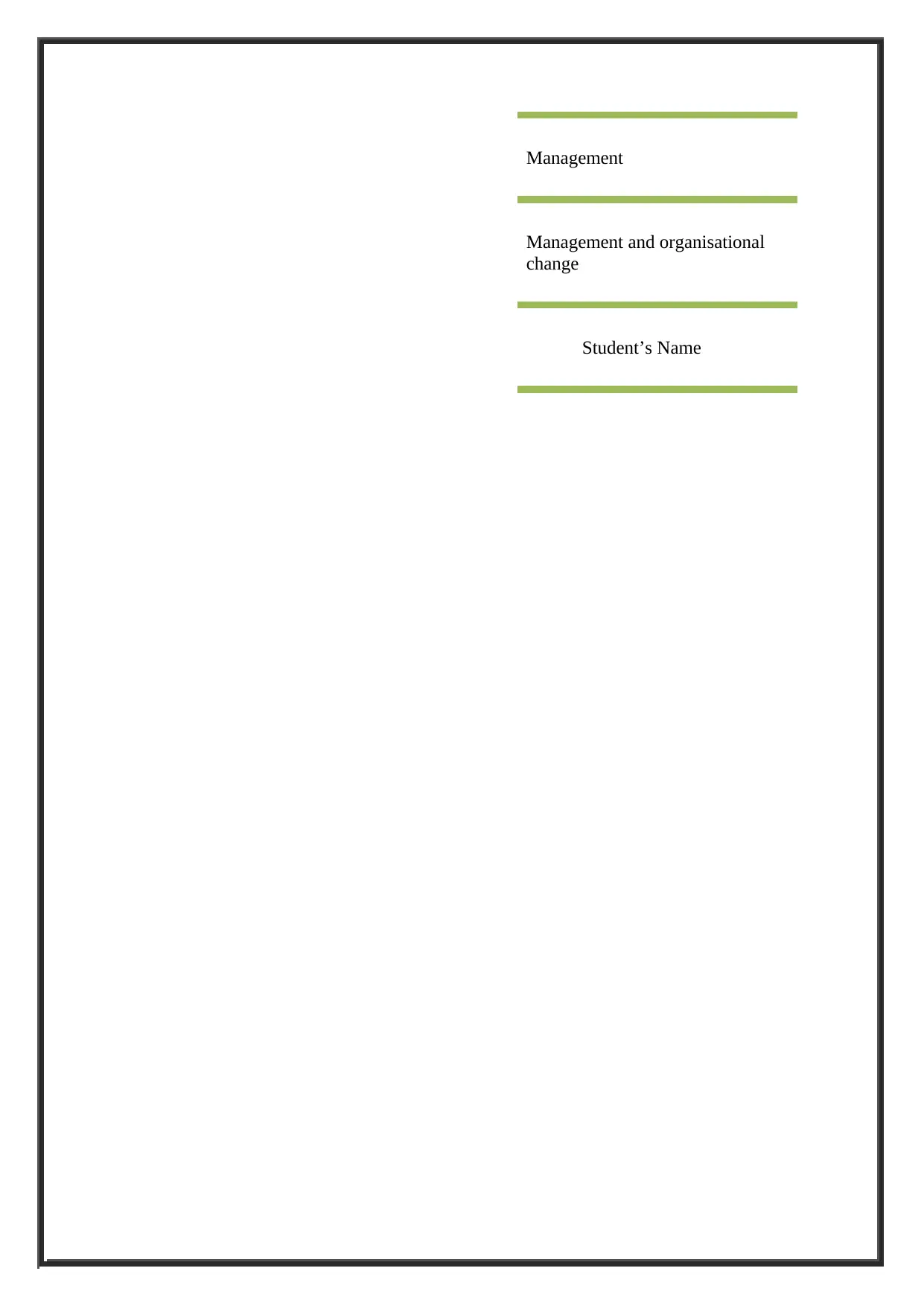
Management
Management and organisational
change
Student’s Name
Management and organisational
change
Student’s Name
Paraphrase This Document
Need a fresh take? Get an instant paraphrase of this document with our AI Paraphraser
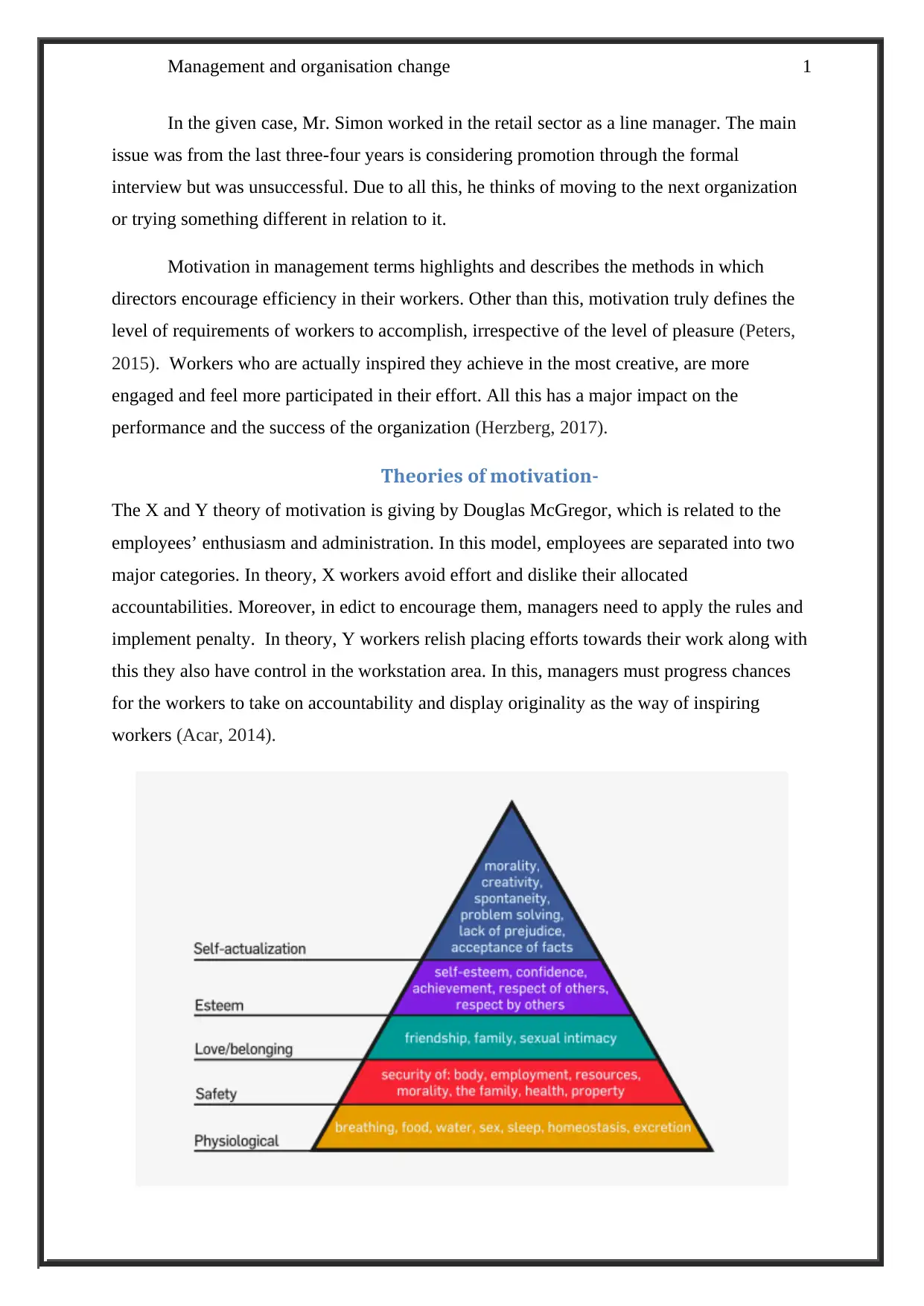
Management and organisation change 1
In the given case, Mr. Simon worked in the retail sector as a line manager. The main
issue was from the last three-four years is considering promotion through the formal
interview but was unsuccessful. Due to all this, he thinks of moving to the next organization
or trying something different in relation to it.
Motivation in management terms highlights and describes the methods in which
directors encourage efficiency in their workers. Other than this, motivation truly defines the
level of requirements of workers to accomplish, irrespective of the level of pleasure (Peters,
2015). Workers who are actually inspired they achieve in the most creative, are more
engaged and feel more participated in their effort. All this has a major impact on the
performance and the success of the organization (Herzberg, 2017).
Theories of motivation-
The X and Y theory of motivation is giving by Douglas McGregor, which is related to the
employees’ enthusiasm and administration. In this model, employees are separated into two
major categories. In theory, X workers avoid effort and dislike their allocated
accountabilities. Moreover, in edict to encourage them, managers need to apply the rules and
implement penalty. In theory, Y workers relish placing efforts towards their work along with
this they also have control in the workstation area. In this, managers must progress chances
for the workers to take on accountability and display originality as the way of inspiring
workers (Acar, 2014).
In the given case, Mr. Simon worked in the retail sector as a line manager. The main
issue was from the last three-four years is considering promotion through the formal
interview but was unsuccessful. Due to all this, he thinks of moving to the next organization
or trying something different in relation to it.
Motivation in management terms highlights and describes the methods in which
directors encourage efficiency in their workers. Other than this, motivation truly defines the
level of requirements of workers to accomplish, irrespective of the level of pleasure (Peters,
2015). Workers who are actually inspired they achieve in the most creative, are more
engaged and feel more participated in their effort. All this has a major impact on the
performance and the success of the organization (Herzberg, 2017).
Theories of motivation-
The X and Y theory of motivation is giving by Douglas McGregor, which is related to the
employees’ enthusiasm and administration. In this model, employees are separated into two
major categories. In theory, X workers avoid effort and dislike their allocated
accountabilities. Moreover, in edict to encourage them, managers need to apply the rules and
implement penalty. In theory, Y workers relish placing efforts towards their work along with
this they also have control in the workstation area. In this, managers must progress chances
for the workers to take on accountability and display originality as the way of inspiring
workers (Acar, 2014).
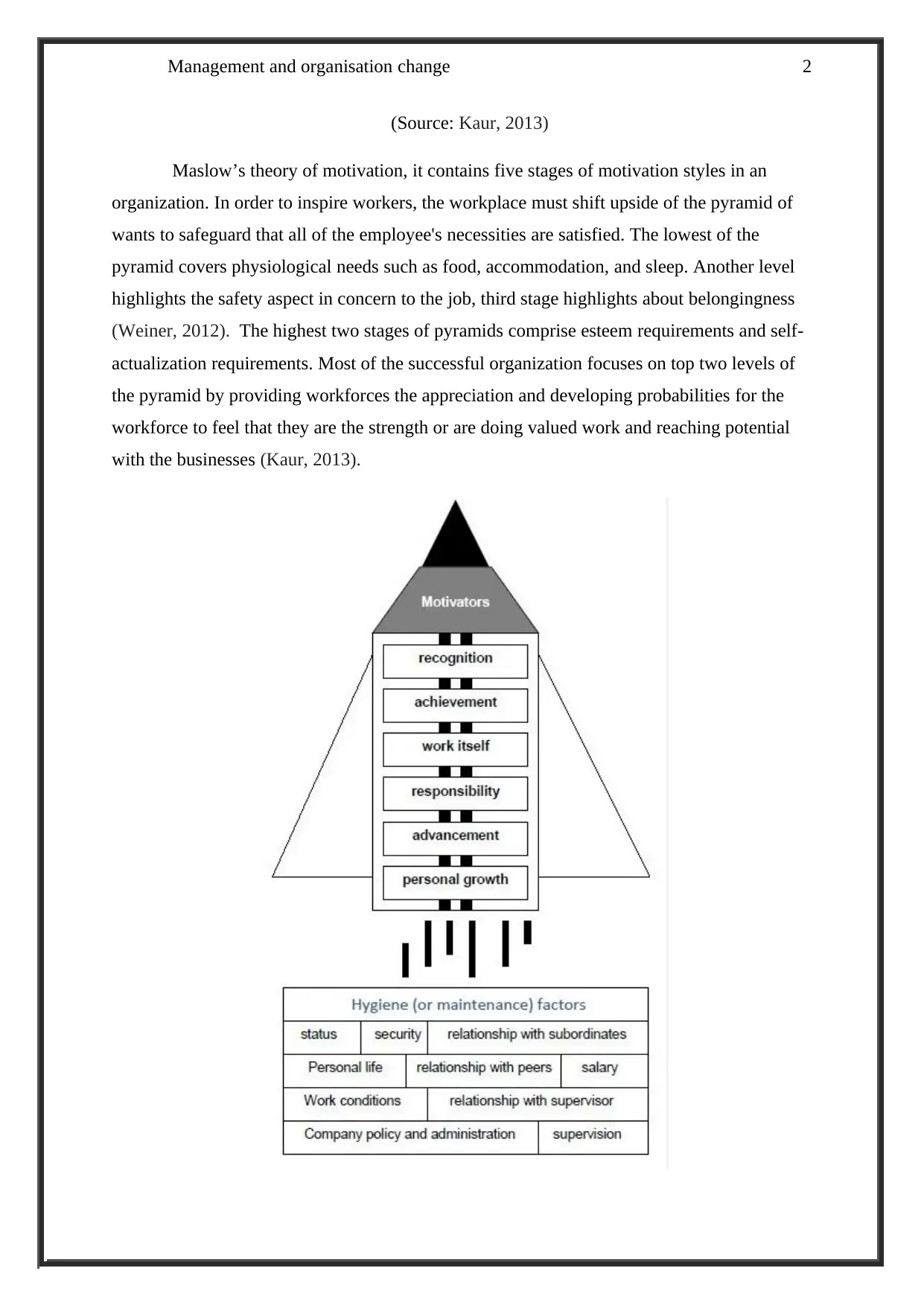
Management and organisation change 2
(Source: Kaur, 2013)
Maslow’s theory of motivation, it contains five stages of motivation styles in an
organization. In order to inspire workers, the workplace must shift upside of the pyramid of
wants to safeguard that all of the employee's necessities are satisfied. The lowest of the
pyramid covers physiological needs such as food, accommodation, and sleep. Another level
highlights the safety aspect in concern to the job, third stage highlights about belongingness
(Weiner, 2012). The highest two stages of pyramids comprise esteem requirements and self-
actualization requirements. Most of the successful organization focuses on top two levels of
the pyramid by providing workforces the appreciation and developing probabilities for the
workforce to feel that they are the strength or are doing valued work and reaching potential
with the businesses (Kaur, 2013).
(Source: Kaur, 2013)
Maslow’s theory of motivation, it contains five stages of motivation styles in an
organization. In order to inspire workers, the workplace must shift upside of the pyramid of
wants to safeguard that all of the employee's necessities are satisfied. The lowest of the
pyramid covers physiological needs such as food, accommodation, and sleep. Another level
highlights the safety aspect in concern to the job, third stage highlights about belongingness
(Weiner, 2012). The highest two stages of pyramids comprise esteem requirements and self-
actualization requirements. Most of the successful organization focuses on top two levels of
the pyramid by providing workforces the appreciation and developing probabilities for the
workforce to feel that they are the strength or are doing valued work and reaching potential
with the businesses (Kaur, 2013).
⊘ This is a preview!⊘
Do you want full access?
Subscribe today to unlock all pages.

Trusted by 1+ million students worldwide
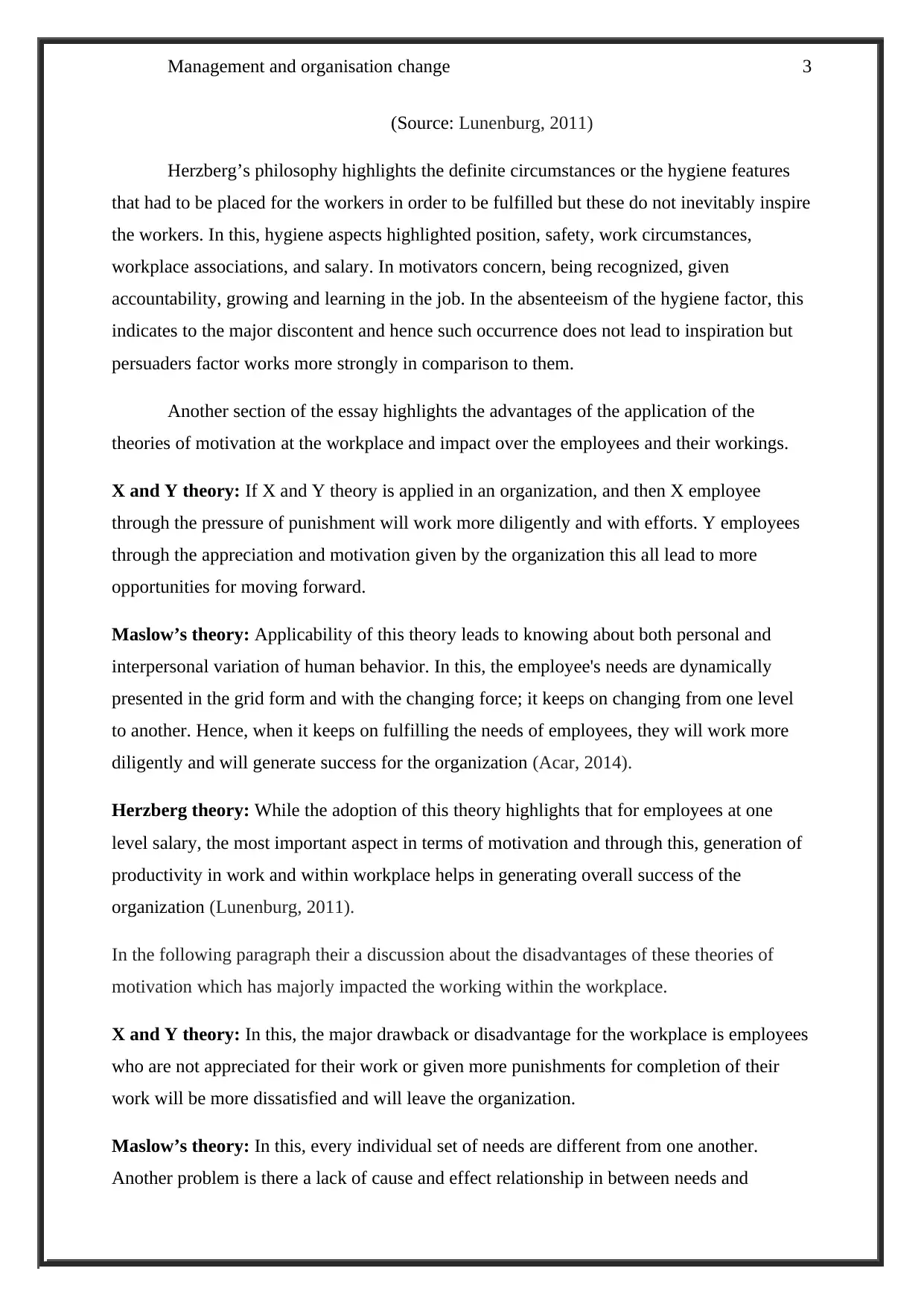
Management and organisation change 3
(Source: Lunenburg, 2011)
Herzberg’s philosophy highlights the definite circumstances or the hygiene features
that had to be placed for the workers in order to be fulfilled but these do not inevitably inspire
the workers. In this, hygiene aspects highlighted position, safety, work circumstances,
workplace associations, and salary. In motivators concern, being recognized, given
accountability, growing and learning in the job. In the absenteeism of the hygiene factor, this
indicates to the major discontent and hence such occurrence does not lead to inspiration but
persuaders factor works more strongly in comparison to them.
Another section of the essay highlights the advantages of the application of the
theories of motivation at the workplace and impact over the employees and their workings.
X and Y theory: If X and Y theory is applied in an organization, and then X employee
through the pressure of punishment will work more diligently and with efforts. Y employees
through the appreciation and motivation given by the organization this all lead to more
opportunities for moving forward.
Maslow’s theory: Applicability of this theory leads to knowing about both personal and
interpersonal variation of human behavior. In this, the employee's needs are dynamically
presented in the grid form and with the changing force; it keeps on changing from one level
to another. Hence, when it keeps on fulfilling the needs of employees, they will work more
diligently and will generate success for the organization (Acar, 2014).
Herzberg theory: While the adoption of this theory highlights that for employees at one
level salary, the most important aspect in terms of motivation and through this, generation of
productivity in work and within workplace helps in generating overall success of the
organization (Lunenburg, 2011).
In the following paragraph their a discussion about the disadvantages of these theories of
motivation which has majorly impacted the working within the workplace.
X and Y theory: In this, the major drawback or disadvantage for the workplace is employees
who are not appreciated for their work or given more punishments for completion of their
work will be more dissatisfied and will leave the organization.
Maslow’s theory: In this, every individual set of needs are different from one another.
Another problem is there a lack of cause and effect relationship in between needs and
(Source: Lunenburg, 2011)
Herzberg’s philosophy highlights the definite circumstances or the hygiene features
that had to be placed for the workers in order to be fulfilled but these do not inevitably inspire
the workers. In this, hygiene aspects highlighted position, safety, work circumstances,
workplace associations, and salary. In motivators concern, being recognized, given
accountability, growing and learning in the job. In the absenteeism of the hygiene factor, this
indicates to the major discontent and hence such occurrence does not lead to inspiration but
persuaders factor works more strongly in comparison to them.
Another section of the essay highlights the advantages of the application of the
theories of motivation at the workplace and impact over the employees and their workings.
X and Y theory: If X and Y theory is applied in an organization, and then X employee
through the pressure of punishment will work more diligently and with efforts. Y employees
through the appreciation and motivation given by the organization this all lead to more
opportunities for moving forward.
Maslow’s theory: Applicability of this theory leads to knowing about both personal and
interpersonal variation of human behavior. In this, the employee's needs are dynamically
presented in the grid form and with the changing force; it keeps on changing from one level
to another. Hence, when it keeps on fulfilling the needs of employees, they will work more
diligently and will generate success for the organization (Acar, 2014).
Herzberg theory: While the adoption of this theory highlights that for employees at one
level salary, the most important aspect in terms of motivation and through this, generation of
productivity in work and within workplace helps in generating overall success of the
organization (Lunenburg, 2011).
In the following paragraph their a discussion about the disadvantages of these theories of
motivation which has majorly impacted the working within the workplace.
X and Y theory: In this, the major drawback or disadvantage for the workplace is employees
who are not appreciated for their work or given more punishments for completion of their
work will be more dissatisfied and will leave the organization.
Maslow’s theory: In this, every individual set of needs are different from one another.
Another problem is there a lack of cause and effect relationship in between needs and
Paraphrase This Document
Need a fresh take? Get an instant paraphrase of this document with our AI Paraphraser
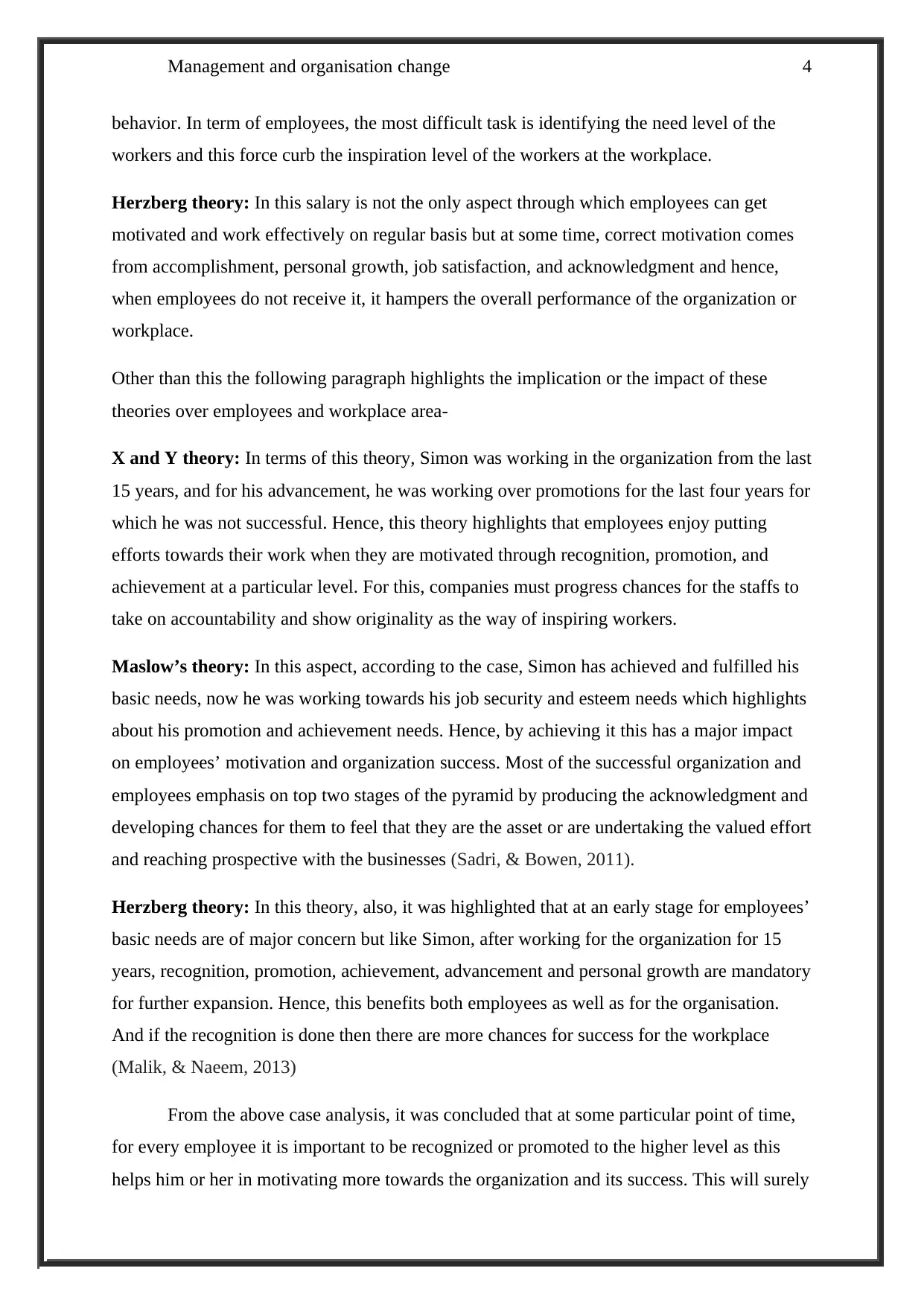
Management and organisation change 4
behavior. In term of employees, the most difficult task is identifying the need level of the
workers and this force curb the inspiration level of the workers at the workplace.
Herzberg theory: In this salary is not the only aspect through which employees can get
motivated and work effectively on regular basis but at some time, correct motivation comes
from accomplishment, personal growth, job satisfaction, and acknowledgment and hence,
when employees do not receive it, it hampers the overall performance of the organization or
workplace.
Other than this the following paragraph highlights the implication or the impact of these
theories over employees and workplace area-
X and Y theory: In terms of this theory, Simon was working in the organization from the last
15 years, and for his advancement, he was working over promotions for the last four years for
which he was not successful. Hence, this theory highlights that employees enjoy putting
efforts towards their work when they are motivated through recognition, promotion, and
achievement at a particular level. For this, companies must progress chances for the staffs to
take on accountability and show originality as the way of inspiring workers.
Maslow’s theory: In this aspect, according to the case, Simon has achieved and fulfilled his
basic needs, now he was working towards his job security and esteem needs which highlights
about his promotion and achievement needs. Hence, by achieving it this has a major impact
on employees’ motivation and organization success. Most of the successful organization and
employees emphasis on top two stages of the pyramid by producing the acknowledgment and
developing chances for them to feel that they are the asset or are undertaking the valued effort
and reaching prospective with the businesses (Sadri, & Bowen, 2011).
Herzberg theory: In this theory, also, it was highlighted that at an early stage for employees’
basic needs are of major concern but like Simon, after working for the organization for 15
years, recognition, promotion, achievement, advancement and personal growth are mandatory
for further expansion. Hence, this benefits both employees as well as for the organisation.
And if the recognition is done then there are more chances for success for the workplace
(Malik, & Naeem, 2013)
From the above case analysis, it was concluded that at some particular point of time,
for every employee it is important to be recognized or promoted to the higher level as this
helps him or her in motivating more towards the organization and its success. This will surely
behavior. In term of employees, the most difficult task is identifying the need level of the
workers and this force curb the inspiration level of the workers at the workplace.
Herzberg theory: In this salary is not the only aspect through which employees can get
motivated and work effectively on regular basis but at some time, correct motivation comes
from accomplishment, personal growth, job satisfaction, and acknowledgment and hence,
when employees do not receive it, it hampers the overall performance of the organization or
workplace.
Other than this the following paragraph highlights the implication or the impact of these
theories over employees and workplace area-
X and Y theory: In terms of this theory, Simon was working in the organization from the last
15 years, and for his advancement, he was working over promotions for the last four years for
which he was not successful. Hence, this theory highlights that employees enjoy putting
efforts towards their work when they are motivated through recognition, promotion, and
achievement at a particular level. For this, companies must progress chances for the staffs to
take on accountability and show originality as the way of inspiring workers.
Maslow’s theory: In this aspect, according to the case, Simon has achieved and fulfilled his
basic needs, now he was working towards his job security and esteem needs which highlights
about his promotion and achievement needs. Hence, by achieving it this has a major impact
on employees’ motivation and organization success. Most of the successful organization and
employees emphasis on top two stages of the pyramid by producing the acknowledgment and
developing chances for them to feel that they are the asset or are undertaking the valued effort
and reaching prospective with the businesses (Sadri, & Bowen, 2011).
Herzberg theory: In this theory, also, it was highlighted that at an early stage for employees’
basic needs are of major concern but like Simon, after working for the organization for 15
years, recognition, promotion, achievement, advancement and personal growth are mandatory
for further expansion. Hence, this benefits both employees as well as for the organisation.
And if the recognition is done then there are more chances for success for the workplace
(Malik, & Naeem, 2013)
From the above case analysis, it was concluded that at some particular point of time,
for every employee it is important to be recognized or promoted to the higher level as this
helps him or her in motivating more towards the organization and its success. This will surely
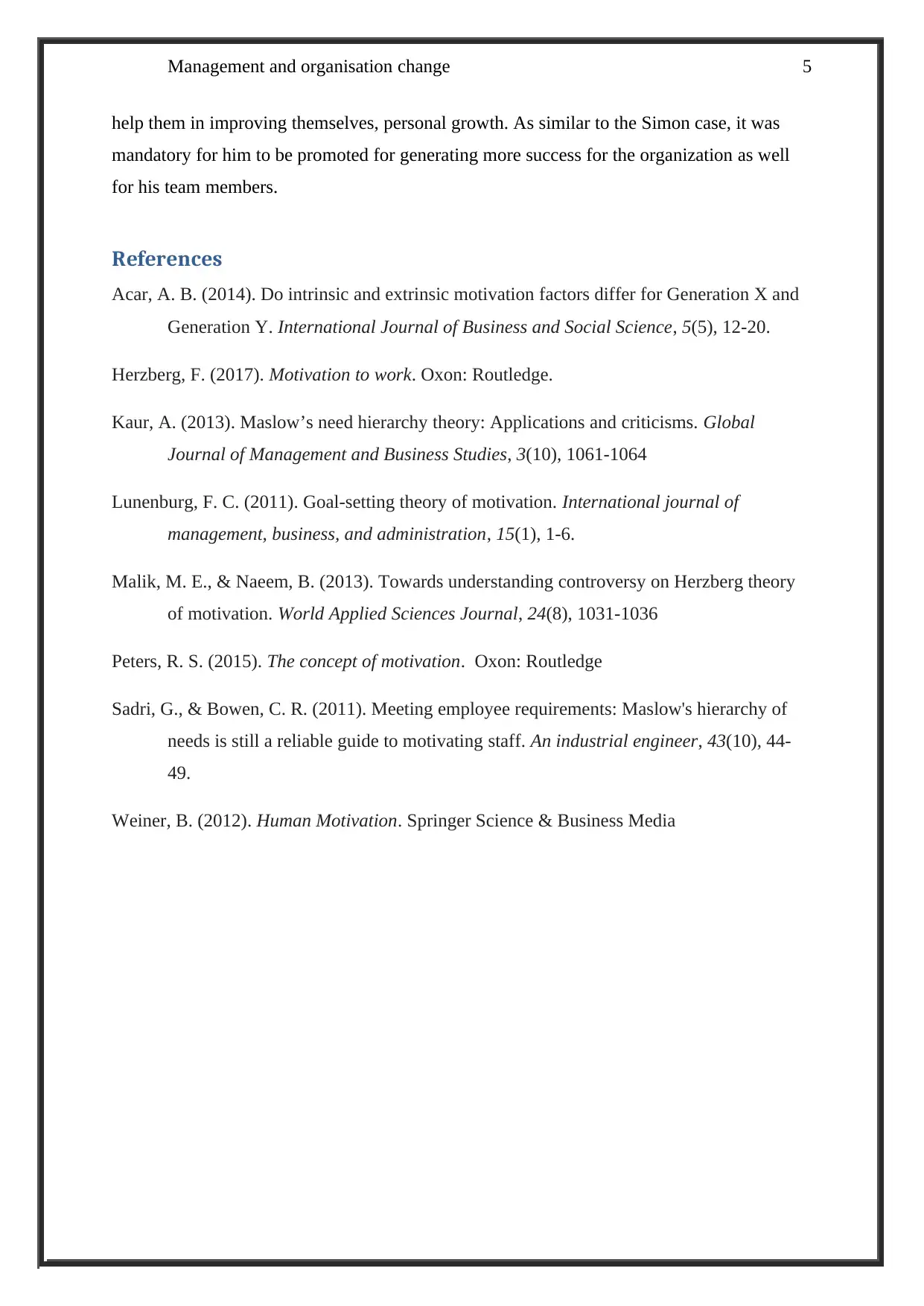
Management and organisation change 5
help them in improving themselves, personal growth. As similar to the Simon case, it was
mandatory for him to be promoted for generating more success for the organization as well
for his team members.
References
Acar, A. B. (2014). Do intrinsic and extrinsic motivation factors differ for Generation X and
Generation Y. International Journal of Business and Social Science, 5(5), 12-20.
Herzberg, F. (2017). Motivation to work. Oxon: Routledge.
Kaur, A. (2013). Maslow’s need hierarchy theory: Applications and criticisms. Global
Journal of Management and Business Studies, 3(10), 1061-1064
Lunenburg, F. C. (2011). Goal-setting theory of motivation. International journal of
management, business, and administration, 15(1), 1-6.
Malik, M. E., & Naeem, B. (2013). Towards understanding controversy on Herzberg theory
of motivation. World Applied Sciences Journal, 24(8), 1031-1036
Peters, R. S. (2015). The concept of motivation. Oxon: Routledge
Sadri, G., & Bowen, C. R. (2011). Meeting employee requirements: Maslow's hierarchy of
needs is still a reliable guide to motivating staff. An industrial engineer, 43(10), 44-
49.
Weiner, B. (2012). Human Motivation. Springer Science & Business Media
help them in improving themselves, personal growth. As similar to the Simon case, it was
mandatory for him to be promoted for generating more success for the organization as well
for his team members.
References
Acar, A. B. (2014). Do intrinsic and extrinsic motivation factors differ for Generation X and
Generation Y. International Journal of Business and Social Science, 5(5), 12-20.
Herzberg, F. (2017). Motivation to work. Oxon: Routledge.
Kaur, A. (2013). Maslow’s need hierarchy theory: Applications and criticisms. Global
Journal of Management and Business Studies, 3(10), 1061-1064
Lunenburg, F. C. (2011). Goal-setting theory of motivation. International journal of
management, business, and administration, 15(1), 1-6.
Malik, M. E., & Naeem, B. (2013). Towards understanding controversy on Herzberg theory
of motivation. World Applied Sciences Journal, 24(8), 1031-1036
Peters, R. S. (2015). The concept of motivation. Oxon: Routledge
Sadri, G., & Bowen, C. R. (2011). Meeting employee requirements: Maslow's hierarchy of
needs is still a reliable guide to motivating staff. An industrial engineer, 43(10), 44-
49.
Weiner, B. (2012). Human Motivation. Springer Science & Business Media
⊘ This is a preview!⊘
Do you want full access?
Subscribe today to unlock all pages.

Trusted by 1+ million students worldwide
1 out of 6
Related Documents
Your All-in-One AI-Powered Toolkit for Academic Success.
+13062052269
info@desklib.com
Available 24*7 on WhatsApp / Email
![[object Object]](/_next/static/media/star-bottom.7253800d.svg)
Unlock your academic potential
Copyright © 2020–2025 A2Z Services. All Rights Reserved. Developed and managed by ZUCOL.





